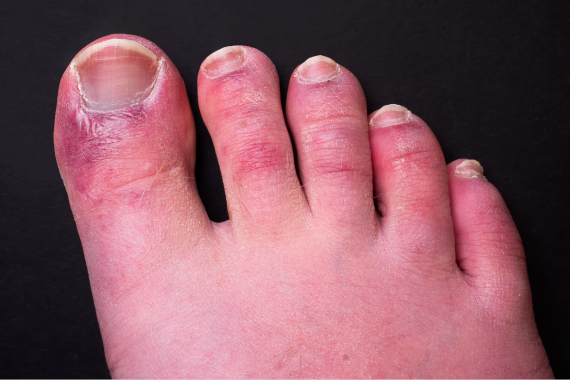Researchers have identified the mechanism behind ‘Covid toe’, suggesting it is a side-effect of the immune response to the virus.
Those with the condition known as ‘Covid toe’ have inflammation and redness on the feet and sometimes fingers which typically develops within one to four weeks of infection.
In a study of 50 participants with the condition and 13 people with similar chilblain lesions that had started before the pandemic, researchers noted some key similarities.
For both groups, they found an immune response with high levels of certain autoantibodies and an overlap with type I interferon, which they noted was a key protein in the antiviral response.
The study, published in the British Journal of Dermatology this week, also seemed to show that Covid toe is associated with endothelial dysfunction.
Overall, a systemic immune response associated with IgA anti-neutrophil cytoplasmic antibodies was found in 73% of patients with symptoms of Covid toe, and elevated type I interferon blood signature compared with healthy controls, the French researchers reported.
The researchers also compared findings with those who had PCR positive mild Covid-19 but without the Covid toe symptoms.
They noted that while the relationship between SARS-Cov-2 and these chilblain-like lesions is still controversial, the recurrence during the second wave of Covid-19 and peaks that tallied with deaths in 2020, strongly suggests there is a close link.
‘Our findings support an activation loop in the skin in [the chilblain-like lesions] associated with endothelial alteration and immune infiltration of cytotoxic and type I IFN-polarised cells leading to clinical manifestations,’ they concluded.
Senior author, Dr Charles Cassius, added that the research provided a deeper understanding of the causes of the condition.
He said: ‘The epidemiology and clinical features of chilblain-like lesions have been extensively studied and published. However, little is known about the pathophysiology involved. Our study provides new insights.’
Last year, a study looking at cutaneous signs of Covid suggested that chillblain-like lesions may occur in young asymptomatics and those with mild disease.
Click to complete relevant dermatology CPD modules on Pulse learning.
Pulse October survey
Take our July 2025 survey to potentially win £1.000 worth of tokens














So, er, what is the treatment?